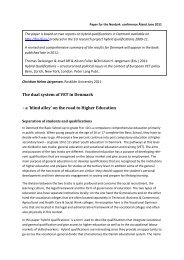Abstractbog printer - ansatte - Roskilde Universitet
Abstractbog printer - ansatte - Roskilde Universitet
Abstractbog printer - ansatte - Roskilde Universitet
You also want an ePaper? Increase the reach of your titles
YUMPU automatically turns print PDFs into web optimized ePapers that Google loves.
Abstracts - Posters<br />
P23. Active predation by Greenland shark Somniosus microcephalus<br />
Julius Nielsen 1,2 , Rasmus Hedeholm 1 , Malene Simon 1 og John Fleng Steffensen 2<br />
1<br />
Grønlands Naturinstitut, P.O. Boks 570, 3900 Nuuk. juliusnielsen88@gmail.com, rahe@natur.gl,<br />
masi@natur.gl<br />
2<br />
Marinbiologisk laboratorium, Strandpromenaden 5, 3000 Helsingør. jfsteffensen@bio.ku.dk<br />
The Greenland shark is ubiquitous in the northern part of the North Atlantic ranging from eastern<br />
Canada to northwest Russia . Although knowledge is scarce it is believed to be abundant and<br />
potentially important part of the ecosystem. Whether Greenland sharks in general should be<br />
considered opportunistic scavengers or active predators is therefore important in understanding<br />
ecosystem dynamics. Due to its sluggish appearance and a maximum reported swimming speed of<br />
74 cm per second scavenging seems the most likely feeding strategy. However, recent studies<br />
suggest that Greenland sharks in some areas feed actively upon seals .<br />
Feeding ecology is poorly described in Greenland waters. In this study we provide information on<br />
feeding habits of 29 sharks caught in Greenland waters in the summer 2012 and show that the<br />
sharks catch epi-benthic species with Atlantic cod being the most important (% IRI = 56 ),<br />
followed by squid (% IRI= 13 ) and wolf fish (IRI=4). Furthermore seal was found in 50 % of all<br />
stomachs (% IRI= 13).<br />
In addition to providing new knowledge of feeding habits of this species in Greenland waters, we<br />
suggest the results show that the Greenland catches the majority of its prey by active predation.<br />
Program 17. danske havforskermøde, 140











